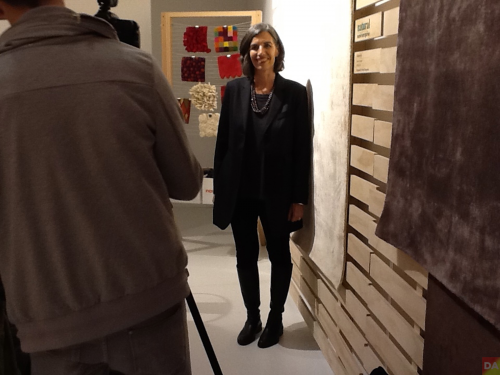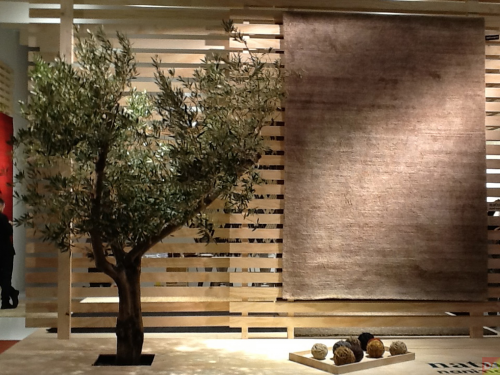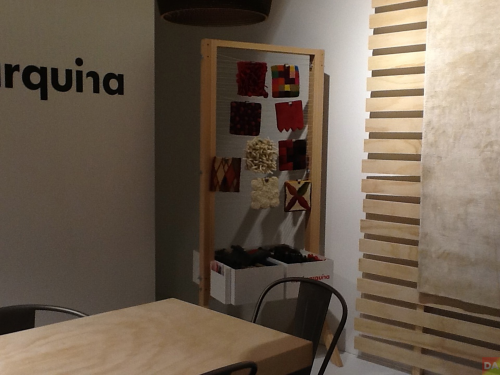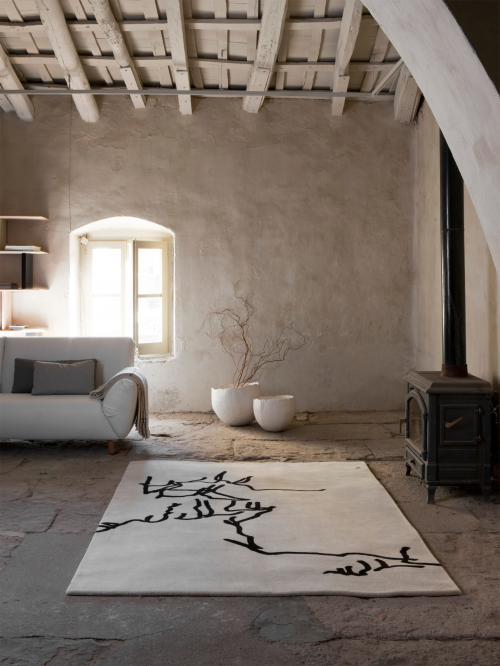Interview with fiber artist Nani marquina. Milan 2013.
 nani will be in booth #1104 ICFF 2013
nani will be in booth #1104 ICFF 2013
[ DesignApplause] Nani, what’s the message this year?
[Nani Marquina] The message is new this year. The message is ‘Natural‘. The concept is to establish a connection with the origin of the materials and the craftsmanship, the old techniques. The fibers, the dyes, are integral to the natural message.

[DA] Any synthetics involved?
[NM] No no. We work with jute, silk AND metal nettle from Napal and Pakistan, and wool from Afganistan. This allows us the options of weaving rugs in different textures and finishes.
[DA] Describe the process? Do you go to these artisans and ask for certain colors and materials and then to a manufacturer with instructions?
[NM] The process is first I have an idea, a vision. The concept if very important. Today we are talking about ‘Natural‘ because people today are working, managing their personal life, today everyone is very busy. Today people want a peaceful, quite quiet refuge from the stressful day-to-day aspect of their life. They want to relax, have fun, and they understand that natural fulfills this need for calm and refuge.
[DA] You’re right. It’s a feeling that natural brings.
[NM] And natural in this moment is about feeling well. It’s both philosophical and real. When we started this philosophy, I traveled to India or Pakistan to search for different materials and craftsmen. I started to make samples experimenting with different weavings and patterns. Then finally we focus on the making of the colors, the natural color palatte palette. And each of these fibers have has their own natural colors. This is the essence of the collection.

[DA] When I see these colors it reminds me of pigments from stones.
[DM] But the dyes are not natural. The dyes are chemical because these natural fibers are very difficult to dye. Nature I guess wishes to protect the fibers and we have to persuade the fibers to absorb the colors, and the light to welcome and reflect the colors using chemicals and this aspect probably will not change. But we keep trying.
[DA] If you can’t find a solution, no one can.
[NM] Our progress so far is limited to very soft color. The red is a pink. Black is a blue. The original color escapes us. We have found some success with a cleaning agent but the problem is this agent is not an ecologic solution, and not because of its chemical structure but it’s an enzyme.
[DA] Right, even though we’re dealing with naturals the processing is a factor. Bamboo processing is very toxic when you’re wanting to achieve a soft solution. How old is this enzyme process and are you exclusive?
[NM] It’s a very recent process created by an Indian woman, a biologist. No, at this moment we are not exclusive. Darn.
[DA] I’m looking at the more complex rugs Nani. Are the designs easy to duplicate?
[NM] No, it’s impossible to duplicate! The buyers understand this and in fact it’s what they want, their own creation. It’s a by-product of handmade. It’s a one-at-a-time unique creation. One reason is the yarn. The yarn itself is irregular, both in texture and color. When weaving whatever happens, happens.
 sample rack
sample rack
[DA] You take your concepts to the weavers. That’s it?
[NM] There are some things where drawings, words, the waving of your hands, is not enough. I ask them for small samples which they send me. There a many variations in texture, pattern and color. To arrive at a collection like natural we need to years.
[DA] What are we looking at here?
[NM] This is collection is from Pakistan and the name is Losanges. It’s a collaboration with the Bouroullec brothers in 2011. We are reinterpreting the traditional Persian rug using an ancient kilim technique. Its’ a complex process involving 13 colors in geometrical rhombus shapes. Very challenging for the weavers.
 losanges | erwan & ronan bouroullec | 2011
losanges | erwan & ronan bouroullec | 2011
[DA] How do you communicate this complex pattern to the weavers?
[NM] We have learned how to talk with computers. The weavers are carefully instructed in the beginning because it’s difficult to grasp the nuances of concepts created by someone else. It’s “yes, you are very close but this angle, this edge needs to go like this.” One Once the prototype is made everyone is ready to go.
[DA] Is there any reason you go to one area, country over another?
[NM] The technique is important to me. For example, India uses a modern technique and Pakistan uses a very old, primitive style. This collection as was Losanges was weaved in Pakistan. We go to the mountains of Afghanistan to follow the sheep. Their wool is what we are looking for here. It’s rough and deep and when the threads are twisted together the end result is very gnarly and interesting. Where we go is not easy to get to with many potential obstacles. We go about once a year for a week to get what we need. Next year this yarn may not be available to us. You never know and it also depends on the collection. But I love this yarn and what it says to me. And it’s very rewarding to recreate the old technique.
[DA] Do you have a vision for the next collection?
[NM] I will be showing a collection in New York City at ICFF collaborating with Milton Glazer. It will be quite interesting and fun.
 chillida collection | 2012
chillida collection | 2012
[DA] Is there anything you wish to say that we haven’t talked about?
[NM] I think this collection is good for this moment because people have been waiting for this concept, they wish to connect with a natural and honest item that they use and cherish. I also like to change. Last year I presented a series of Spanish artist, Eduardo Chillida, work which goes back to Figura Humana 1948, through Dibujo Tinta 1957. We created seven of his most famous drawings. The Chillida Collection has been very well received. I enjoyed creating Chillida last year and this year Milton Glazer.
[ nani marquina ] [ bouroullec brothers ] [ ICFF 2013 booth #1104 ]


